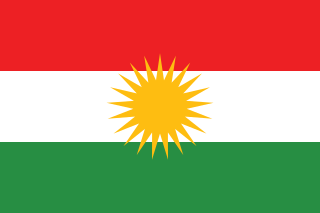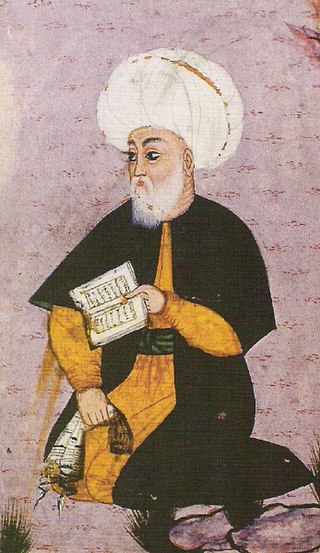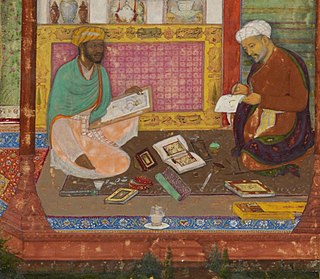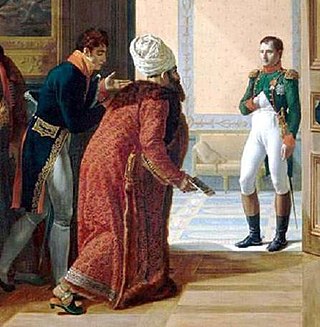
Persian, also known by its endonym Farsi, is a Western Iranian language belonging to the Iranian branch of the Indo-Iranian subdivision of the Indo-European languages. Persian is a pluricentric language predominantly spoken and used officially within Iran, Afghanistan, and Tajikistan in three mutually intelligible standard varieties, namely Iranian Persian, Dari Persian and Tajiki Persian. It is also spoken natively in the Tajik variety by a significant population within Uzbekistan, as well as within other regions with a Persianate history in the cultural sphere of Greater Iran. It is written officially within Iran and Afghanistan in the Persian alphabet, a derivative of the Arabic script, and within Tajikistan in the Tajik alphabet, a derivative of the Cyrillic script.

Kurds or Kurdish people are an Iranian ethnic group native to the mountainous region of Kurdistan in Western Asia, which spans southeastern Turkey, northwestern Iran, northern Iraq, and northern Syria. There are exclaves of Kurds in Central Anatolia, Khorasan, and the Caucasus, as well as significant Kurdish diaspora communities in the cities of western Turkey and Western Europe. The Kurdish population is estimated to be between 30 and 45 million.

A cushion is a soft bag of some ornamental material, usually stuffed with wool, hair, feathers, polyester staple fiber, non-woven material, cotton, or even paper torn into fragments. It may be used for sitting or kneeling upon, or to soften the hardness or angularity of a chair or couch. Decorative cushions often have a patterned cover material, and are used as decoration for furniture.

The Topkapı Palace, or the Seraglio, is a large museum and library in the east of the Fatih district of Istanbul in Turkey. From the 1460s to the completion of Dolmabahçe Palace in 1856, it served as the administrative center of the Ottoman Empire, and was the main residence of its sultans.

A couch, also known as a sofa, settee, or chesterfield, or davenport, is a cushioned item of furniture for seating multiple people. It is commonly found in the form of a bench with upholstered armrests and is often fitted with springs and tailored cushion and pillows. Although a couch is used primarily for seating, it may be used for sleeping. In homes, couches are normally put in the family room, living room, den, or lounge. They are sometimes also found in non-residential settings such as hotels, lobbies of commercial offices, waiting rooms, and bars. Couches can also vary in size, color, and design.

Ottoman Turkish was the standardized register of the Turkish language used by the citizens of the Ottoman Empire. It borrowed extensively, in all aspects, from Arabic and Persian, and its speakers used the Ottoman Turkish alphabet for written communication. During the peak of Ottoman power, words of foreign origin in Turkish literature in the Ottoman Empire heavily outnumbered native Turkish words, with Arabic and Persian vocabulary accounting for up to 88% of the Ottoman vocabulary in some texts.

A divan or diwan was a high government ministry in various Islamic states, or its chief official.
Turkish literature comprises oral compositions and written texts in the Turkish language. The Ottoman form of Turkish, which forms the basis of much of the written corpus, was highly influenced by Persian and Arabic literature, and used the Ottoman Turkish alphabet.

Diyarbakır, formerly Diyarbekir, is the largest Kurdish-majority city in Turkey. It is the administrative center of Diyarbakır Province.

An ottoman is a piece of furniture. Generally ottomans have neither backs nor arms. They may be an upholstered low couch or a smaller cushioned seat used as a table, stool or footstool. The seat may have hinges and form a lid for the inside hollow, which can be used for storage of linen, magazines or other items, making it a form of storage furniture. The smaller version is usually placed near to an armchair or sofa as part of living room decor or may be used as a fireside seat.

In the late eighteenth century, the Ottoman Empire faced numerous enemies. In response to these threats, the empire initiated a period of internal reform. The period of these reforms is known as the Tanzimat, and led to the end of the Old Regime period. The Ottoman central state was significantly strengthened, despite the empire's precarious international position. Over the course of the nineteenth century, the Ottoman state became increasingly powerful and rationalized, exercising a greater degree of influence over its population than in any previous era. The process of reforming and modernization in the empire began with the declaration of the Nizam-I Cedid during the reign of Sultan Selim III and was punctuated by several reform decrees, such as the Hatt-ı Şerif of Gülhane in 1839 and the Hatt-ı Hümayun in 1856.

Muhammad bin Suleyman, better known by his pen name Fuzuli, was a 16th-century poet who composed works in his native Azerbaijani, as well as Persian and Arabic. He is regarded as one of the greatest poets of Turkic literature and a prominent figure in both Azerbaijani and Ottoman literature. Fuzuli's work was widely known and admired throughout the Turkic cultural landscape from the 16th to the 19th centuries, with his fame reaching as far as Central Asia and India.

In Islamic cultures of the Middle East, North Africa, Sicily and South Asia, a Diwan is a collection of poems by one author, usually excluding his or her long poems (mathnawī).
Dewan designated a powerful government official, minister, or ruler. A dewan was the head of a state institution of the same name. Diwans belonged to the elite families in the history of Mughal and post-Mughal India and held high posts within the government.
Diwan and divan are variant terms originally used in Persian, Arabic, and Turkish with derivates in other Asian and European languages such as diwaan, dewan, etc.. These terms may refer to:

A dragoman was an interpreter, translator, and official guide between Turkish-, Arabic-, and Persian-speaking countries and polities of the Middle East and European embassies, consulates, vice-consulates and trading posts. A dragoman had to have a knowledge of Arabic, Persian, Turkish, and European languages.
The poetry of the Ottoman Empire, or Ottoman Divan poetry, is little known outside modern Turkey, which forms the heartland of what was once the Ottoman Empire. It is, however, a rich and ancient poetic tradition that lasted for nearly 700 years, and one whose influence can still be felt in the modern Turkish poetic tradition.

Kurdish nationalism is a nationalist political movement which asserts that Kurds are a nation and espouses the creation of an independent Kurdistan from Iran, Iraq, Syria, and Turkey.

Liwan is a long narrow-fronted hall or vaulted portal in ancient and modern Levantine homes that is often open to the outside. An Arabic loanword to English, it is ultimately derived from the Persian eyvān, which preceded by the article al ("the"), came to be said as līwān in Arabic, and later, English.
Khuda is the Persian word for God. Originally, it was used in reference to Ahura Mazda although it is now widely used to refer to the God in Islam as well. Iranian languages, Turkic languages, and many Indo-Aryan languages employ the word. Today, it is a word that is largely used in the non-Arabic Islamic world, with wide usage from its native country Iran, Turkey, Afghanistan, Azerbaijan, Bangladesh, Kazakhstan, Pakistan, Tajikistan, Turkmenistan, Uzbekistan, and some Muslim-majority areas of India, as well as southern and southwestern Russia.
















